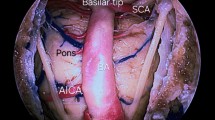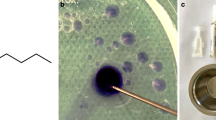Abstract
Neurotoxicity from contrast media used in angiography is a rare complication from these procedures. The infrequency with which it is encountered makes it a diagnostic challenge. We present the case of a 51-year-old male who, 30 min after successful angiography for treatment of a right carotid-ophthalmic fusiform aneurysm with a stent, developed psychomotor agitation, disorientation, and progressive left faciobrachial hemiparesis (4/5). An emergency nonenhanced CT showed marked cortical enhancement and edema in the right cerebral hemisphere. Cortical enhancement is thought to be secondary to contrast extravasation due to disruption of the blood–brain barrier. Angiography was performed immediately, without any pathologic findings. After this procedure there was an increase in the left faciobrachial hemiparesis (3/5), right gaze deviation, Gerstmann syndrome, and left anosognosia and left homonymous hemianopsia. Endovenous dexamethasone and mannitol were initiated. Twenty-four hours later an MRI showed no signs of acute infarct, just gyriform signal increase in the right cerebral hemisphere on FLAIR and a decrease in the edema observed before. The patient had progressive improvement of his neurological deficit. A control MRI done 5 days later was normal. The patient recovered completely and was discharged. This rare entity should be kept in mind but diagnosed only when all other causes have been ruled out, because more important and frequent causes, such as acute infarct, must be excluded promptly.



Similar content being viewed by others
References
Davis K, Kennedy JW, Kemp HG et al (1979) Complications of coronary arteriography from the collaborative study of coronary artery surgery (CASS). Circulation 59:1105–1111
De Bono D (1993) Complications of diagnostic cardiac catheterization: results from 34,041 patients in the United Kingdom confidential enquiry into cardiac catheterization complications. Br Heart J 70:297–300
Studdard WE, Davis DO, Young SW (1981) Cortical blindness after cerebral angiography. J Neurosurg 54:240–244
Utz R, Ekholm SE, Isaac L, Sands M, Fonte D (1988) Local blood–brain barrier penetration following systemic contrast medium administration. Acta Radiol 29:237–242
Rama BN, Pagano TV, Del Core M et al (1993) Cortical blindness after cardiac catheterization: effect of re-challenge with dye. Cathet Cardiovasc Diagn 28:149–151
Kermode AG, Chakera T, Mastaglia FL (1992) Low osmolar and non-ionic X-ray contrast media and cortical blindness. Clin Exp Neurol 29:272–276
Sharp S, Stone J, Beach R (1999) Contrast agent neurotoxicity presenting as subarachnoid hemorrhage. Neurology 52:1503–1505
Lantos G (1989) Cortical blindness due to osmotic disruption of the blood–brain barrier by angiographic contrast material: CT and MRI studies. Neurology 39:567–571
Shyn PB, Bell KA (1989) Transient cortical blindness following cerebral angiography. J La State Med Soc 141(Suppl 2):35–37
Kinn RM, Breisblatt WM (1991) Cortical blindness after coronary angiography: a rare but reversible complication. Catheter Cardiovasc Diagn 22:177–179
Parry R, Rees JR, Wilde P (1993) Transient cortical blindness after coronary angiography. Br Heart J 70:563–564
Sticherling C, Berkefeld J, Auch-Schwelk W, Lanfermann H (1998) Transient bilateral cortical blindness after coronary angiography. Lancet 351:570
Saigal G, Bhatia R, Bhatia S, Wakhloo A (2004) MR findings of cortical blindness following cerebral angiography: is this entity related to posterior reversible leukoencephalopathy? Am J Neuroradiol 25:252–256
Dangas G, Monsein L, Laureno R et al (2001) Transient contrast encephalopathy after carotid artery stenting. J Endovasc Ther 8:111–113
Bradbury MW (1979) The concept of a blood–brain barrier. Wiley, London
Orvik A, Walday P (1995) Neurotoxicity of water-soluble contrast media. Acta Radiol 399(Suppl):221–229
Caille JM, Allard M (1988) Neurotoxicity of hydrosoluble iodine contrast media. Invest Radiol 23(Suppl 1):5210–5212
Merchut MP, Richie B (2002) Transient visuospatial disorder from angiographic contrast. Arch Neurol 59:851–854
Schwartz RB, Jones KB, Kalina P et al (1992) Hypertensive encephalopathy: findings on CT, MR imaging and SPECT imaging in 14 cases. Am J Roentgenol 159:379–383
Heistad DD (1984) Protection of the blood–brain barrier during acute and chronic hypertension. Fed Proc 43:205–209
Ay H, Buonanno FS, Schaefer PW et al (1998) Posterior leukoencephalopathy without severe hypertension: utility of diffusion-weighted MRI. Neurology 51:1369–1376
Henzlova MJ, Coghlan HC, Dean LS et al (1988) Cortical blindness after left internal mammary artery to left anterior descending coronary artery graft angiography. Cathet Cardiovasc Diagn 15:37–39
Skinner JS, Jackson MJ, Gholkar A, Adams PC (1995) Cortical blindness during left internal mammary angiography. Int J Cardiol 52:119–123
Antonellis J, Kostopoulos K, Rambaouni A et al (1996) Cortical blindness following coronary angiography: a rare but self-cured complication. Angiology 47:803–806
Lim KK, Radford DJ (2002) Transient cortical blindness related to coronary angiography and graft study. Med J Aust 177(1):43–44
Author information
Authors and Affiliations
Corresponding author
Rights and permissions
About this article
Cite this article
Guimaraens, L., Vivas, E., Fonnegra, A. et al. Transient Encephalopathy from Angiographic Contrast: A Rare Complication in Neurointerventional Procedures. Cardiovasc Intervent Radiol 33, 383–388 (2010). https://doi.org/10.1007/s00270-009-9609-4
Received:
Revised:
Accepted:
Published:
Issue Date:
DOI: https://doi.org/10.1007/s00270-009-9609-4




